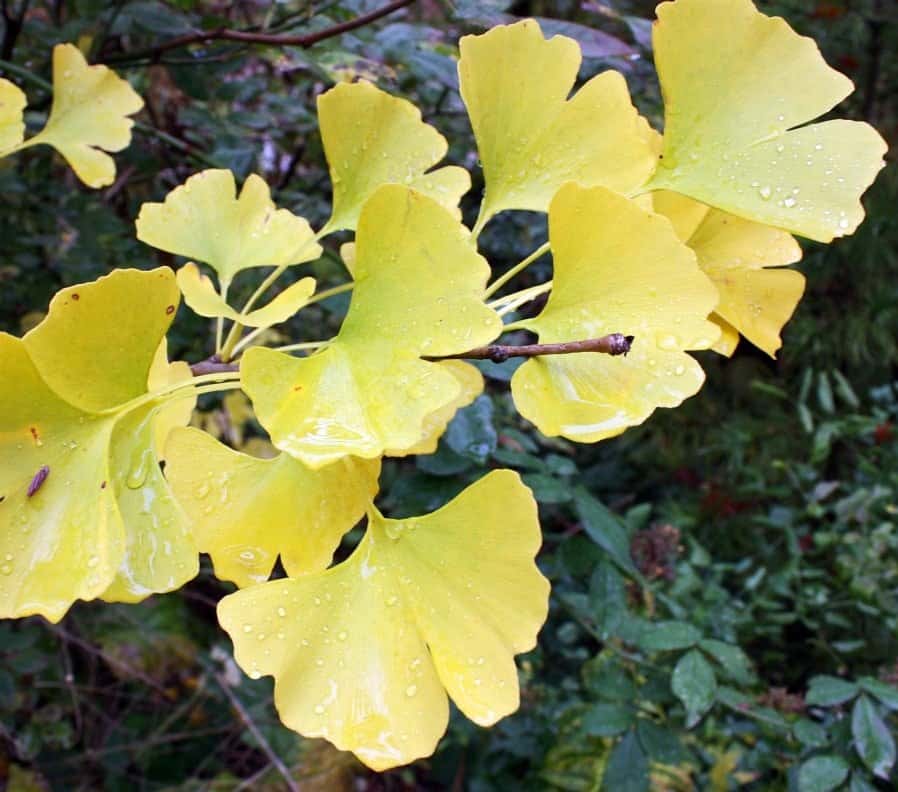
When thinking about vivid autumn foliage, I focus on red and orange. But then a reader wrote about her beautiful yellow larch, and that made me turn around and see (hiding in plain sight) my gorgeous yellow ginkgo tree (Ginkgo biloba, Zone 5). The ginkgo has the best autumn yellow in my garden—a bright and cheery glow that stands out from other faded plants.
The ginkgo is a pleasing tree in all seasons, and truth be known, I have two. (You might have guessed that I seldom buy one of anything, especially when two is better!) It’s drought hardy, tolerant of all soils and doesn’t mind air pollution. What I like best is the unusual arrangement of foliage sprouting from the wood and outlining the branches. You don’t get a lot of dense twiggy growth with ginkgos—as they say down on the farm, a robin can fly right through the crown. This makes it an interesting architectural subject that fits almost any place, including perennial beds. I can plant all around it with no root interference, and the branches don’t make too much shade. One of my ginkgos is in love with a ‘Clair Matin’ climbing rose that sprawls all through it for support. I put the second ginkgo at the top of the path between my house and a neighbour. It shot right up and made wasted space into a pretty garden entrance. In time the bark becomes striped, providing a good winter feature.
Ginkgos have been found in rock fossils dating back 200 million years. Can you imagine how many autumns of yellow display that is?
Other posts by Judith this week:
Posts by Judith last week:

How can I order a the ginkgo tree that the leaves turn yellow.
the green one is a ginkgo. the leaves have turned yellow and fallen. i will leave the new shoots because they are growing much better than the mother plant. thanks for replying. sue turner
Hi Brigitte,
Yes, the ginkgo is a favourite of mine, too. It’s tolerant of city conditions, not fussy about soil, and not affected by polluted air, all of which makes it a good boulevard tree. But city trees are often neglected, and particularly suffer from inadequate moisture. That’s probably why the municipal ginkgos are slow to grow. Few people think to care for city-planted trees, but they would be much healthier and grow faster if watered regularly. If you have one outside your home, try to water it every time you water your garden.
— Judith
Hello Cindi,
You’re very patient! The move may be just what this ginkgo needs. In spring, I would suggest giving it a dose of liquid concentrate transplant solution containing indole-butyric acid (IBA). Dilute it in a watering can following the container directions, and water the solution into the soil over the root zone. Look for this fertilizer product at the garden centre. The key ingredient for your purpose is the IBA, which is a root growth stimulant. The tree won’t put any top growth on without first growing roots. If you can induce root growth with the IBA, you should see some vertical growth next summer. Once it starts to extend vertically, the rate should be reasonably fast. I have one ginkgo grown from a rooted cutting, and it grows about 12 inches (30 cm) each year. Frequent moisture and good drainage are usually all that’s needed to get good growth on trees. Hope you’ll see some upward movement next year.
— Judith
My ginkgo tree is approximate 8 years old and I don’t think it has grown a foot in this time period. It is still only two feet tall but healthy. This fall I moved it, hopefully to a better site. You mentioned that it should be growing 8 – 16 inches per year. Any suggestions to why it is growing so slowly. (I give it lots of compost each year).
You mention the yellow leaves. Mine are long gone but my tulip tree (Liriodendron tulipifera) still has beautiful large yellow leaves..spectacular!
The Ginkgo’s fan-shaped leaves are so lovely, I can’t resist picking up a few off the ground whenever I see them. I’ve got them pressed in books all over the house and office! It seems like the City of Halifax has been planting them all over the municipality – perhaps it’s their replacement tree of choice. I’ve noticed that those Ginkgoes seem to grow very slowly. Are there any fast-growing varieties that are good for our climate?
Hi Sue,
Do you think both trees are ginkgos? The green one might be something else, unless it’s slow to turn yellow in autumn. If the tree is grafted onto another tree’s root stock, that might explain the shoots coming up. Do they appear identical to the tree? In any event, if the tree is doing well, then you might want to remove the shoots. But if the tree is failing (perhaps from the compacted clay soil), it could be trying to renew itself with new shoots. It’s your choice whether to keep them or not.
— Judith
Hello Bev,
How interesting! The ginkgo cultivar you have may be ‘Gresham’, which is described as horizontally spreading, no ascending or descending branches, discovered in front of Gresham Union High School, Gresham, Oregon. It’s relatively slow growing, probably 8 to 16 inches (20 to 40 cm) a year. I’ve never seen one, and you’re fortunate to have it.
— Judith
Hi:
I have a lovely weeping Gingko. It actually seems to grow parallel rather than weep. What facinates me is the beautiful yellow leaves all seem to fall on the same day.
i, too, have a yellow one as well as a green variety. i’ve had the green one for about 10 years. it is planted in dense clay soil which routinely floods with heavy rainfalls. this year it sent up several new shoots from the ground. should i remove them?